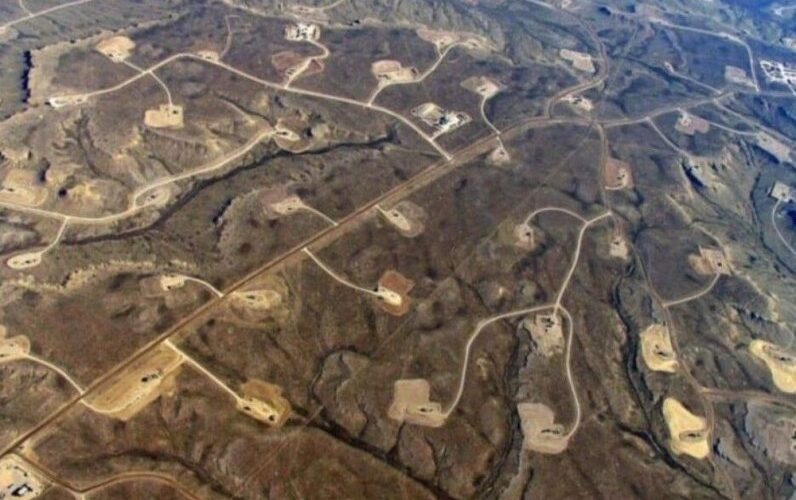The David Suzuki Foundation is in hot water. On July 3, eight residents from the Peace region in northern B.C. filed a formal complaint with Canada’s Competition Bureau. They allege the Foundation used a 20-year-old aerial photo of fracking wells in Wyoming to depict what fracking looks like in British Columbia’s Montney region.
The image in question is a desolate grid of industrial pads cut into arid land; it was published repeatedly on Suzuki Foundation websites, Instagram, Facebook, and even donation solicitations. The problem? It’s not B.C. It’s Jonah Field, Wyoming, taken around 2006 by Bruce Gordon of EcoFlight. It’s Jonah Field, Wyoming, taken around 2006 by Bruce Gordon of EcoFlight.
And according to the complaint (PDF), the image was still being used in 2025, long after the Foundation had been alerted.
The core of the complaint isn’t just geographic laziness. It’s that the image paints a false picture of what fracking in B.C. actually looks like today. Thanks to horizontal drilling, Montney wells tend to be centralized, greener, and far less visually jarring. To use an image of Wyoming’s older style of gas development and imply it represents B.C.’s environmental impact is, at best, misleading.
The group of residents is accusing the Foundation of violating Sections 9 and 10 of Canada’s Competition Act, which prohibit materially false or misleading representations. And thanks to reforms in Bill C-59, passed in 2024, environmental claims now need to be backed by proper evidence. No exceptions for charities. Penalties can go as high as $15 million per offence.
The Foundation hasn’t responded publicly yet. But a wave of coverage has followed:
I don’t think anyone at the Suzuki Foundation woke up saying, “Let’s trick the public today.” I think what happened is more human, more bureaucratic, and more revealing.
In spaces where mission urgency is everything, aesthetic truth starts to replace factual truth. It feels emotionally true: fracking is bad, we need to stop it, people need to see the harm. So an image like that gets used not because it’s accurate, but because it tells the story harder.
Staff move fast. Campaigns need content. Someone Googles “fracking aerial photo” and finds a dramatic shot. It gets added to a report. Then a tweet. Then a donation page. Months pass. The image is now part of the brand’s emotional lexicon. No one stops to re-vet it. Or if they do, the sense is: “Does it matter? It’s all true in spirit.”
That logic is everywhere. It’s not exclusive to the right or the left. It’s just what happens when the mission becomes more important than the means.
Usually when we talk about greenwashing, we’re pointing at oil companies selling us “clean gas” or banks pretending to be net zero. But this story flips the script. This time, it’s a beloved environmental NGO accused of telling a prettier story than the truth allows.
Is it still greenwashing if the lies are told for a good cause?
Apparently, yes. And now, it’s illegal in Canada. Thanks to recent changes in the Competition Act, advocacy groups, just like corporations, need to show evidence behind any environmental claim they make, especially if they’re soliciting donations.
This is probably a good thing. But it’s also an awkward one. Because it forces us to confront something we don’t like admitting:
Even the good guys can use propaganda. And sometimes, they don’t even know they’re doing it.
Propaganda isn’t always malicious. It can creep in when we’re too sure we’re right, and the facts feel too slow, too inconvenient, or too small for the message we want to get across.
The problem is, every time the left tells a distorted story, even with the best intentions, it hurts the credibility of real solutions. It teaches people not to trust advocacy. It gives actual polluters the ability to say, “See? Everyone lies.”
And worst of all: it turns truth into just another tactic.
So maybe the better path is this:
- Let stories be strong and specific.
- Let urgency coexist with accuracy.
- Let the truth be enough, even when it’s less dramatic.
Because in a world full of manipulation, telling the truth plainly is the most radical thing you can do.
